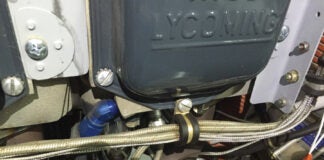Big Brother Is My Copilot
I appreciate the sentiments expressed by Tom Wilson in his February 2019 column. Any information transmitted via ADS-B beyond position and velocity is not related to safety. The rest is an infringement on privacy, provides nothing more than a clear opportunity for abuse, and if the anecdotal evidence is correct, never deleted. It never fails to surprise me how as pilots we accept this.
—Walt Peters
Air/Fuel Ratio Monitoring
I have a question about Figure 4 in Reinhard Metz’s article, “Adding Direct Air/Fuel Ratio Monitoring” in the March 2019 issue. Why the variations in the A/F ratio along the bottom axis? For example, the column width between 12.5 and 13 is 0.25. The column width between 14.7 and 16 is 0.65. Either the numbers are not correct or the scale of the graph has been distorted.
—George King
Reinhard Metz responds: Thanks for your attention to detail. However, the A/F numbers on the X-axis of Figure 4 are correct—they are just nonlinear as an artifact of the way the data was acquired and how Excel does X-Y graphs.
The data was generated by flying a constant altitude and manifold pressure, and varying the fuel flow in -gph (equally spaced) increments, and recording the corresponding A/F ratios, airspeeds, and EGTs. As a result, in Figures 2, 3, and 5, where the X-axis is fuel flow, the numbers are equally spaced. However, in Figure 4, where the X-axis is A/F, Excel simply plots the A/F numbers in sequential order, equally spaced. Since the A/F ratios corresponding to equally spaced fuel flows are not necessarily equally spaced, the X-axis ends up non-linear. The plotted data for each of these numbers is correct, and the graph smoothing is simply a second order interpolation applied by Excel.
If you’d like to see the actual data, you can download the original spreadsheet.
In retrospect, it would have been less confusing if I had flown another set of tests with equal increments of A/F ratio, or plotted the existing data on a linear axis.
Used Homebuilts
In “Buying a Used Homebuilt” [March 2019], Dave Prizio implies (but did not actually say) that only properly licensed persons may maintain and repair aircraft registered as E-LSA. The fact is that anyone may work on, maintain, and repair E-LSA aircraft, even the teenager next door neighbor who only has experience playing video games. In addition, a new owner of a used E-LSA may modify the aircraft any way they want as long as it still meets the definition of an LSA.
—Joe Gores
Dave Prizio responds: Joe makes a good point about E-LSA maintenance. Anyone may work on an E-LSA aircraft. However, as I pointed out in my article, only the holder of a Light Sport repairman certificate (with inspection rating) or an A&P mechanic may perform the yearly condition inspection of an E-LSA. Anyone planning to work on E-LSA aircraft would be well served to get some professional training before doing so, but that training and certification are not required except for those who wish to perform condition inspections. As Joe said, the language in my article was not clear on this subject.













